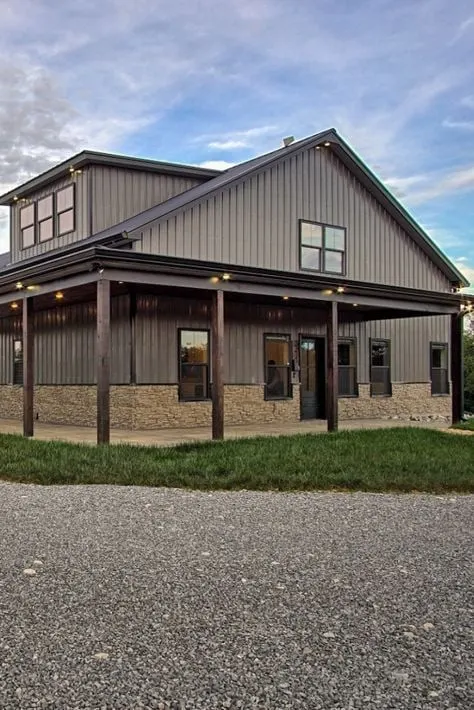Sustainable Staying In a Barndominium: EcoFriendly Features to Think About When Structure
As the pattern of barndominium living gains traction, the assimilation of sustainable techniques is coming to be significantly essential for eco aware building contractors. By choosing energy-efficient products, checking out renewable energy choices, and implementing ingenious water conservation systems, one can considerably improve the environmental impact of these versatile structures.
Energy-Efficient Structure Products
When creating a barndominium, picking energy-efficient building materials is important for promoting sustainability and minimizing overall power consumption. The choice of products directly impacts the building's thermal performance, sturdiness, and environmental impact. Lasting options such as reclaimed timber, bamboo, and recycled metal not just minimize source depletion but also decrease waste in garbage dumps.
Additionally, concrete, when sourced responsibly, can be a reliable energy-efficient product. It provides superb thermal mass, assisting to regulate interior temperatures and lower reliance on home heating and cooling systems. High-performance windows with low-E coverings and shielded structures can considerably improve power efficiency by minimizing warmth transfer.
An additional factor to consider is the installation of energy-efficient roofing materials, such as metal, which reflects solar power, thereby minimizing air conditioning costs. Incorporating these materials not only sustains a greener lifestyle however can likewise cause lasting monetary savings through minimized energy bills.

Lasting Insulation Options

Cellulose insulation is derived from recycled paper products, supplying an eco-friendly choice with outstanding thermal efficiency. Its capacity to resist moisture and lower air leakage makes it specifically effective in maintaining consistent interior temperatures (click here to view). Sheep's wool insulation is another all-natural alternative, supplying premium breathability and dampness management while being naturally degradable
For those taking into consideration spray foam, selecting items with low global warming potential and high renewable material can further improve sustainability. Barndominium repair. Additionally, reflective insulation panels made from recycled products can be integrated to boost power efficiency by reducing warm loss
Eventually, purchasing sustainable insulation not just minimizes energy consumption but also advertises a comfortable living space, aligning with the principles of eco-friendly living. Careful factor to consider of insulation materials will add to the long-term sustainability and performance of a barndominium.
Water Conservation Equipment
Applying reliable water conservation systems is essential for making best use of sustainability in a barndominium. Among the most impactful techniques is the installation of rain harvesting systems. By collecting and keeping rain from the roofing system, home owners can considerably lower their dependence on local water products while offering a lasting resource for irrigation and non-potable uses.
Furthermore, incorporating greywater recycling systems can further boost water conservation efforts - click here. These systems enable the reuse of wastewater from sinks, showers, and laundry, directing it back into the irrigation system or bathrooms. This technique not only conserves water however likewise decreases the concern on septic tanks
Low-flow components and appliances, such as taps, showerheads, and toilets, are also crucial components in water preservation. These components can minimize general water use without sacrificing performance, making them an efficient choice more helpful hints for eco-conscious contractors.
Lastly, landscaping with drought-resistant plants can minimize water demands for exterior rooms. Native and adapted plant types commonly need much less water and upkeep, adding to a lasting living setting. By carrying out these water conservation systems, barndominium proprietors can develop a much more eco-friendly and resource-efficient home.
Renewable Power Resources
Taking advantage of sustainable power resources is an essential element of sustainable living in a barndominium. These panels transform sunshine right into power, dramatically reducing reliance on fossil fuels and reducing energy expenses.
One more feasible option is wind power. Mounting a little wind generator can offer an additional source of renewable resource, especially in locations with regular wind patterns. Wind wind turbines convert kinetic power from the wind into power, enhancing solar power by generating power throughout gloomy days or at evening.
Geothermal heating and cooling down systems can likewise contribute to energy performance. By using the secure temperature levels underground, these systems can substantially reduce the power required for cooling and heating, making them excellent for barndominiums in different climates.
Incorporating these sustainable power sources not just cultivates a sustainable way of living yet additionally boosts the total worth of the residential or commercial property. By purchasing such modern technologies, homeowners can achieve power self-reliance, decrease their carbon impact, and add to a much more lasting future.
Eco-Friendly Landscape Design Ideas
Developing an environmentally friendly landscape boosts both the aesthetic appeal and sustainability of a barndominium. By integrating indigenous plants, home owners can promote biodiversity while reducing water usage and upkeep. Native types are well-adapted to the regional climate, requiring much less irrigation and fertilizer.
Furthermore, consider executing permaculture principles, which concentrate on designing landscapes that work harmoniously with nature. This can consist of planting edible gardens, fruit trees, and pollinator-friendly flowers to produce a self-reliant environment. Rain gardens, created to catch and absorb stormwater, are an additional effective way to take care of overflow and boost dirt health and wellness.
Using organic composts and compost not only enhances the dirt yet additionally minimizes the need for chemical plant foods. Incorporating permeable paving products for walkways and driveways can aid prevent water runoff, promoting groundwater recharge.
Conclusion
